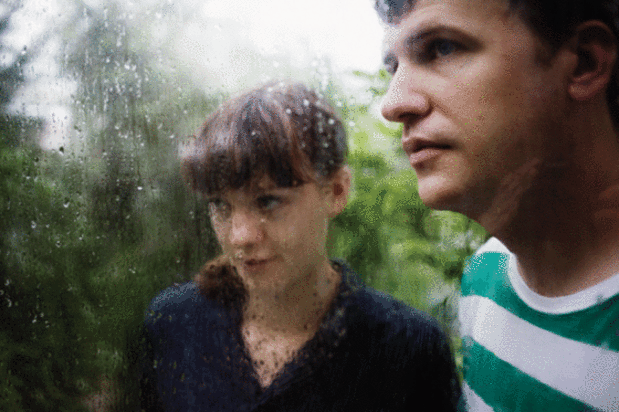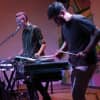Before seeing them this Saturday at the East Village Radio festival, read T Cole Rachel's feature story on Brooklyn, New York's High Places from FADER Number 56.
Story T. Cole Rachel
Photography Gabriele Stabile
Unless you went to school there, most people would have no idea that Brooklyn’s Pratt Institute is home to one of New York’s oldest steam-powered electricity generators (which is miraculously still in use) and a wily population of free-roaming cats. I didn’t go to Pratt, and wouldn’t know these facts either, unless Mary Pearson and Rob Barber, better known as High Places, hadn’t shown me. Standing inside the giant engine—surrounded by belted steel generators and a handful of lounging felines that occasionally hop inside through an open window—I notice the duo staring at a large assemblage of copper steam whistles. They are transfixed. “Imagine what kinds of noises we could make with that,” Barber says.
?Such sentiments—born from a sense of discovery and an almost naïve optimism—are key in understanding what has made High Places one of the most steadfastly interesting bands to emerge over the past year. Having toured with the likes of Deerhunter and No Age, High Places have established themselves as part of what appears to be an emerging movement. They represent a generation of young bands that, while not necessarily connected by geography or a particular sound, share a similar aesthetic, a love for coaxing unusual sounds out of familiar objects and familiar sounds out of unusual objects. They operate under a diverse and inclusive ideology, and there is a palpaple lack of pretense in regards to their art. “People are sometimes confused about seeing us play with bands like No Age,” says Barber, “but we think of ourselves in the same way that they do. We just don’t sound the same, and shouldn’t that be a good thing?”
?Much like their friends Lucky Dragons and Telepathe, High Places produce a sort of electronic ephemera—an inscrutable mélange of layered percussion and syncopated computer sounds made with a diversity of real instruments and pieced together via computer. While many of their contemporaries take that concept to a decidedly colder or dance-friendly place, High Places go to one that is both warm and organic. Early singles like “Sandy Feat” and “Shared Islands” demonstrated what has become the band’s trademark—a crafty assortment of drum sounds and gently loping beats that dance around Pearson’s sing/speak vocals about nature and god and, occasionally, housecats.
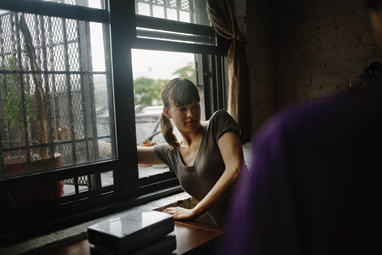
The story of High Places is really a story about friendship, albeit a somewhat unlikely one. After being introduced through a mutual friend at a show in New York City, Pearson and Barber quickly formed a kind of insta-bond that would eventually blossom into a musical collaboration and an almost sitcom-like domestic partnership. “We were sort of just talking to each other on the phone all the time, emailing daily, sharing ideas about stuff. Eventually she was just like, Can I move in with you?” says Barber. Pearson, who was finishing a music degree in bassoon performance in Kalamazoo, Michigan, was eager to leave her college town and move to the city. At the time, each musician was nurturing their own solo endeavors. “My project consisted of me playing a bassoon and a set of bells, accompanied by a tape recording of rustling leaves and clocks. I probably only performed by myself five or six times,” says Pearson. Barber, busy teaching printmaking at Pratt and trying to develop his own music (“Very scrapbooky sound pieces,” he calls them), was happy to find a like-minded collaborator. Pearson moved to New York in early 2006. Shortly thereafter, the two booked a show opening for Japanther as High Places before actually writing any songs. The creation of the band allowed the duo to play shows and go on mini-tours with friends (the third ever High Places show was with No Age in LA, for an audience of about six people), and what was originally intended to be only a summer in New York for Pearson before heading off to grad school quickly became a full-time creative endeavor with a new best friend.
?
“The world she was coming from was something that I really missed—potluck dinners, house shows, so nerdy, but so exciting,” says Barber. “I think we were enamored with each other’s lives. She wanted to live in the city, and I saw this person whose motivation for doing things was something that I really missed. We thought it would just be a lark—like maybe we’d play some little shows and make home recordings that would be it. Luckily, it wasn’t. People just kept asking us to play.”
?Both Pearson and Barber are quick to clear up one major misconception about the band: the two of them are not—nor have they ever been—a couple. “People are confused by us sometimes, I think,” says Pearson. “The idea that we’re best friends of a different gender and different ages [she is 24, he is 34] is hard for people to figure out. We’re not dating and we’re not related. I don’t understand why that is such a big deal for people, but everyone is always fascinated by the dynamic of our friendship.”
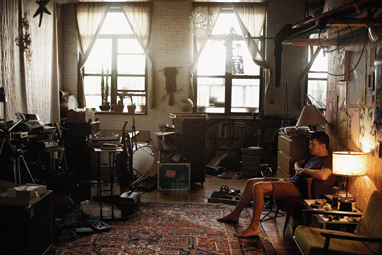
In the same way that alcoholics will often say they can spot another alcoholic in a crowd, I have a similar theory about cat people. I’m thinking about this as I enter the Clinton Hill loft that Pearson and Barber call home, not only because there are two cats present (a brother and sister duo named Granola and Cosmonaut), but because there is all manner of cat paraphernalia on display. Cat related artwork, scratching posts, even a small painting (given to Pearson by a friend) of her two cats lounging on a flower-covered hillside along with his two cats. “Is it possible not to love that?” she asks.
The apartment itself—which includes a makeshift bedroom for Mary, a sleeping loft for Rob and a wall of windows looking out across Brooklyn—is like a big recording studio, albeit a messy one. In addition to an array of amps, guitars and the scattered components of a drum set, there are at least three computers, two samplers and an imposing stockpile of percussion instruments. The walls are covered with prints, paintings, notes and old posters for High Places shows. Paper snowflakes suspended from the ceiling brush the top of my head as I walk through the kitchen. “Please excuse the mess,” says Pearson, welcoming me inside. “We’ve been kind of busy.”
?
Fresh from a tour of Europe crammed in the same van as Deerhunter, the two have spent the past two days overseeing the final mastering of their self-titled first album. In a few days the band will head back out on the road, this time touring the states with No Age. Now that they have given up their day jobs (his as a printmaking instructor, hers as a Manhattan nanny), they can focus their attention fully on the business of making music, even though neither of them care to think about it as a business. They mainly see it as a means of being able to travel and play and make things. “We just came back from a month in the UK,” says Pearson. “While everyone else was out drinking and getting no sleep, we were figuring out ways to go sightseeing and actually experience the places we were visiting. We are kind of nerds about it.”
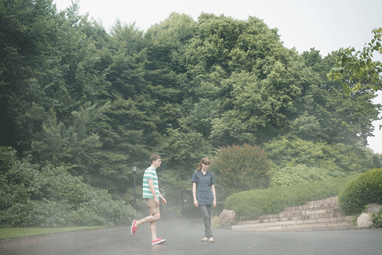
Built on the same dreamy, collage-like vibe of early singles (recently compiled and released as 03/07-09/07), their Thrill Jockey debut presents High Places in a much more cohesive light. Like everything the band has ever released, the record was created entirely at home using an archaic computer program and utilizing every shaker, drum, sampler and plastic bag that could be found around the apartment. Spread over ten tracks that blend almost seamlessly into each other, there is a certain sonic sameness to everything that High Places does. Taken casually, it can sound like subtle variations on the same idea, however, repeated listens to the album (a headphone record if ever there was one) reveal just how layered and complicated the compositions actually are. Tracks like “The Storm” (the driving hook of which sounds as if it was created by a de-tuned sitar and a chorus of anxious rattlesnake tails) are nearly impossible to deconstruct. A variety of mysterious percussions—jangling keys? bells? wooden blocks? sandpaper?—bubble up in the mix and quickly disappear, thick bass jumps from left to right in the mix and even the most overtly electronic noises end up sounding vaguely natural and hand-hewn. Most songs build in mantra-like fashion before dissolving completely just shy of the four-minute mark. The pastoral textures and gentle, Caribbean-inflected drums (“People always want to ask us about the influence of tropicália, but it’s totally incidental” says Barber) often belie the lyrics, which vacillate between optimistic yearning and delicate musings on discovery. As Pearson sings on “Vision’s the First…”: Oh how very strange/ We cannot look away/ And nothing you could say/ Would ever make us go away.
Sitting at the band’s favorite Mexican restaurant in Brooklyn, discussion turns inevitably to Kelly Clarkson, who is blasting over the restaurant’s stereo. “Not everybody making music is an extrovert,” says Barber. “In fact, I think the opposite is often the case. We can’t all be belting out ‘Since You Been Gone’ or ripping off Lightning Bolt. I made home recordings for over ten years and none of them ever saw the light of day. I just did it for fun, but I was also kind of terrified of putting myself out there. Working with Mary definitely gave me the courage to do that. Still, when we’re up on stage it’s not like we’re trying to be rock stars. We’re just doing our thing. I guess that makes us weird.”
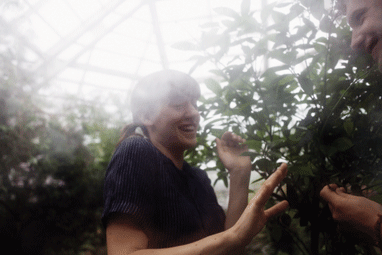
The truth is, the only weird thing about Pearson and Barber is how absolutely not weird they seem. In fact, one might assume that the two actually were siblings save for the fact that siblings would probably get annoyed with each other more often. The two exude the same good-natured curiosity that imbues the music they make. “People have criticized us for not being more animated on stage,” says Pearson. “We only know how to be ourselves, I guess. We make the kind of music that seems natural to us. We play it in the way that makes the most sense. We want the music to sound as good as it can and we want people to enjoy it, but ultimately we just want to have fun and make something that we feel good about. It’s not really that complicated.”
A few final things to know about High Places: they are vegan; they rarely, if ever, drink or do drugs; they rarely, if ever, curse in front of me (“Our families can read this stuff!”); and they are extremely conscientious—if not a little overly careful—about the way they present themselves. During my two days with them they will often ask each other, “Is it okay to say that?” before answering a question or diving headlong into a story. It all might be too much—too cute and maddeningly cautious—if they weren’t so damned nice. In fact, they are the most polite band I’ve ever gone shopping for organic vegetables with. When I start to poke fun at their resolute positivity, Pearson is happy to join in. “You know, it’s all about energy,” she says with a laugh. “I feel the energy of the universe coming through me and all I can do is channel it…”
?“Oh, don’t joke about that,” says Barber, “People probably already think that’s really how we are. He already thinks we’re crazy cat people.”
“But we are!” Pearson responds.
